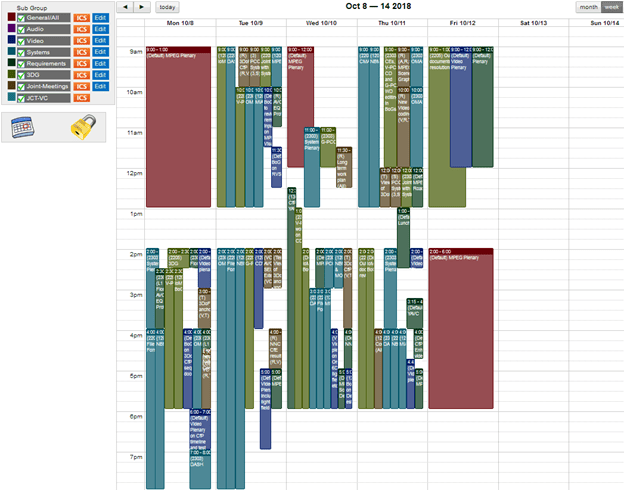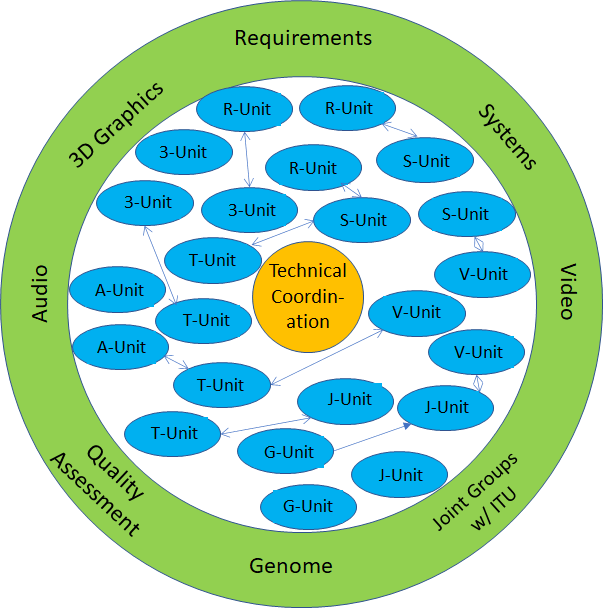Introduction
For 30 years industry has been accustomed to rely on MPEG as the source of standards the industry needs. In 30 years MPEG has held a record 129 meetings, roughly spaced by 3 months.
What happens if MPEG130 is not held? Can industry afford it?
In this article I will try and answer this non so hypothetical question.
An MPEG meeting (physical)
In Looking inside an MPEG meeting I have illustrated the “MPEG cycle” workflow using the figure below

At the plenary session of the previous N-1th meeting, MPEG approves the results achieved and creates some 25 Ad hoc Groups (AhGs). Taking one example from MPEG129, each AhG has a title (Compression of Neural Networks for Multimedia Content Description and Analysis), chairs (Werner Bailer, Sungmoon Chun and Wei Wang) and a set of mandates:
- Collect more diverse types of models and test data for further use cases, working towards a CfP for incremental network representation
- Perform the CEs and analyse the results
- Improve the working draft and test model
- Continue analyzing the state of the art in NN compression and exchange formats
- Continue interaction with SC42, FG ML5G, NNEF, ONNX and the AI/ML community
Work is carried out during the typical ~3 months between the end of the N-1th and the next Nth meeting using e-mail reflector or conference calls or, less frequently, physical meetings. Documents are shared by AhG members using the MPEG Document Management System (MDMS).
When the date of the next meeting approaches, AhGs wrap up their conclusions and many of them hold physical meetings on the week-end prior to the “MPEG week”.
On the Monday morning of the MPEG week, AhGs report their results to the MPEG plenary. In the afternoon, subgroups (Requirements, Systems, Video, Joint groups with ITU, Audio, 3DG and Test) hold short plenaries after which Break-out Groups (BoGs), often a continuation of AhGs, carry out their work interspersed with joint meetings of subgroups and BoGs.
Two more plenaries are held: on Wednesday morning to make everybody aware of what has happened in groups a member might not have had the opportunity to attend and on Friday afternoon to ratify or, if necessary, reconsider, decisions made by the subgroups.
The Convenor and the Chairs meet at night to assess progress and coordinate work between subgroups and BoGs. A typical function is the identification of joint meetings.
ICT at the service of MPEG
Some 500 people are involved in an MPEG week, At times some 10-15 meeting sessions are held in parallel.
Most of this is possible because of the ICT facilities MPEG prides itself of. Developed by Christian Tulvan, they run on servers made available by Institut Mines Télécom.
Currently the MPEG Meeting Support System (MMSS) includes a calendar where subgroup chairs record all subgroup and BoG sessions adding a description of the topics to be discussed. The figure below gives a snapshot of the MMSS calendar. This of course has several views to serve different needs.

In Digging deeper in the MPEG work, I described MDMS and MMSS. Originally deployed in 1995, MDMS has been one of the greatest contributors to MPEG’s skyrocketing rise in performance. In addition to providing the calendar, MMSS also enables the collation of all results produced by the galaxy of MPEG organisational units depicted below.

The third ICT support is the MPEG Workplan Management System (MWMS). This provides different views of the relevant information on MPEG standards that is needed to execute the workplan.
MPEG online?
Now imagine, and probably you don’t have to stretch you imagination too much, that physical meetings of people are banned but industry requests are so pressing that a meeting must be held, no matter what, because product and service plans depend so much on MPEG standards.
MPEG is responding to this call of duty and is attempting the impossible by converting its 131st (physical) meeting of 500 experts to a full online meeting retaining as much as possible the modus operandi depicted in the figures above.
In the following I will highlight how MPEG is facing what is probably its biggest organisational challenge ever.
The first issue to be considered is that, no matter how skilfully MPEG will handle its first online meeting, productivity is going to be less than a physical meeting could yield. This is because by and large the majority of the time of a physical MPEG meeting is dedicated to intense technical discussions in smaller (and sometimes not so small) groups. At an online meeting, such discussions will at best be a pale replica of the physical meeting where experts are pressed by the number and the complexity of the issues, the argument they make, the little time available, the need to get to a conclusion and a clumsier handling of the interventions.
MPEG is facing this challenge by asking AhGs to come to the online meeting with much more solid conclusions than usual so that the results that will be brought to the online meeting will be more mature and will require less debate to be adopted. This has generated a surge in conference calls by the groups who are more motivated by the need to achieve firm results at the next meeting.
Another way to face the challenge is by being realistic in what is achievable at an online meeting, Issues that are very complex and possibly less urgent will be handled with a lower priority or not considered at all, of course if the membership agrees. Therefore the management will set the meeting goals, balancing urgency, maturity and achievability of results. Of course experts, individually or via AhGs, will have an opportunity to make themselves heard.
Yet another way to face the challenge is by preparing a very detailed assignment of time slots to issues during the entire week in advance of the MPEG week. So far this was done only partially because MPEG allowed as much time as possible to experts to prepare and upload their contributions for others to study and to be ready to discuss at the meeting. This has always forced the chairs to prepare their schedule at the last minute or even during the week as the meeting unfolds. This time MPEG asks its experts to submit their contributions one full week before with an extended abstract to facilitate the task of the chairs who have to understand tens and sometimes hundreds of contributions and properly assign them to homogeneous sessions.
The schedules will balance the need to achieve as many results as possible (i.e. parallel sessions) with giving the opportunity to as many members as possible to attend (i.e. sequential sections).
The indefatigable Christian Tulvan, the mind and the arm behind MDMS and MMSS, is currently working to extend MMSS to enable the chairs to add the list of documents to be considered and to create online session reports shared with and possibly co-edited by session participants.
So far MPEG has been lenient most of the time to late contributions (accepted if there is consensus to review the contribution). This time late contributions will simply not be considered.
No matter how good the forecast will be, It is expected that the schedule will change while the week progresses. If a change during the meeting is needed, it will be announced at least 24 hours in advance.
The next big challenge is the fact that MPEG is a truly global organisation. We do not have Hawaiian experts in attendance, but we do have experts from Australia (East Coast) to the USA (West Coast). That makes a total of 19 time zones. Therefore MPEG130 online will be conducted in 3 time slots starting at 05:00, 13:00 and 21:00 (times are GMT). The sessions inside will have durations less than 2 hours followed by a break.
Conclusions
Last but not least. MPEG is confident that the current emergency will be called off soon. The situation we are facing, however, is new and we simply don’t know when it will be over and if it will be for once or if this is just the first of future pandemics.
With MPEG130 online, MPEG not only wants to respond to the current industry needs, but also to fine tune its processes in an online context to be always ready to serve the industry and the people industry serves, no matter which are the external circumstances.
I don’t underestimate the challenge MPEG is facing with MPEG130 online, but I know I can rely on a dedicated leadership and membership.
Posts in next thread
Posts in this thread
- Developing MPEG standards in the viral pandemic age
- The impact of MPEG on the media industry
- MPEG standards, MPEG software and Open Source Software
- The MPEG Metamorphoses
- National interests, international standards and MPEG
- Media, linked media and applications
- Standards and quality
- How to make standards adopted by industry
- MPEG status report (Jan 2020)
- MPEG, 5 years from now
- Finding the driver of future MPEG standards
- The true history of MPEG’s first steps
- Put MPEG on trial
- An action plan for the MPEG Future community
- Which company would dare to do it?
- The birth of an MPEG standard idea
- More MPEG Strengths, Weaknesses, Opportunities and Threats
- The MPEG Future Manifesto
- What is MPEG doing these days?
- MPEG is a big thing. Can it be bigger?
- MPEG: vision, execution,, results and a conclusion
- Who “decides” in MPEG?
- What is the difference between an image and a video frame?
- MPEG and JPEG are grown up
- Standards and collaboration
- The talents, MPEG and the master
- Standards and business models
- On the convergence of Video and 3D Graphics
- Developing standards while preparing the future
- No one is perfect, but some are more accomplished than others
- Einige Gespenster gehen um in der Welt – die Gespenster der Zauberlehrlinge
- Does success breed success?
- Dot the i’s and cross the t’s
- The MPEG frontier
- Tranquil 7+ days of hard work
- Hamlet in Gothenburg: one or two ad hoc groups?
- The Mule, Foundation and MPEG
- Can we improve MPEG standards’ success rate?
- Which future for MPEG?
- Why MPEG is part of ISO/IEC
- The discontinuity of digital technologies
- The impact of MPEG standards
- Still more to say about MPEG standards
- The MPEG work plan (March 2019)
- MPEG and ISO
- Data compression in MPEG
- More video with more features
- Matching technology supply with demand
- What would MPEG be without Systems?
- MPEG: what it did, is doing, will do
- The MPEG drive to immersive visual experiences
- There is more to say about MPEG standards
- Moving intelligence around
- More standards – more successes – more failures
- Thirty years of audio coding and counting
- Is there a logic in MPEG standards?
- Forty years of video coding and counting
- The MPEG ecosystem
- Why is MPEG successful?
- MPEG can also be green
- The life of an MPEG standard
- Genome is digital, and can be compressed
- Compression standards and quality go hand in hand
- Digging deeper in the MPEG work
- MPEG communicates
- How does MPEG actually work?
- Life inside MPEG
- Data Compression Technologies – A FAQ
- It worked twice and will work again
- Compression standards for the data industries
- 30 years of MPEG, and counting?
- The MPEG machine is ready to start (again)
- IP counting or revenue counting?
- Business model based ISO/IEC standards
- Can MPEG overcome its Video “crisis”?
- A crisis, the causes and a solution
- Compression – the technology for the digital age

